

Because radio is a genre-specific medium, advertisements aired on radio may reach a more focused audience. The reason for this is three-fold: radio is portable, free and adaptable accessible in cars and available through computers, phones and smart speakers. Radio, both terrestrial and streaming, continues to be a powerful media, reaching more than 90% of members of each age demographic each day. All can be mediums to complement your other efforts, depending on your overall goals.

Terrestrial and streaming radio are very viable options, as are digital display ads, paid search, paid social and outdoor advertisements. Let’s not lose sight of other mediums available. Suffice it to say there is a generational gap.
#Media consumption tv#
In terms of TV consumption, individuals in these groups watch just over 1.5 hours of television programming a day, while those 65+ watch seven times that amount. The trend of cord-cutting is more readily embraced by a younger demographic, specifically Gen Y and millennials. That being said, OTT does not have the local reach that advertisers can enjoy with local TV advertising.īefore you stop all traditional TV advertising and devote your resources entirely to OTT, review the goals of your messaging and your target consumer. Despite this refined focus of the placements, streaming (OTT) advertising can come at a fraction of the cost per ad than traditional (linear) TV, and the results of the placements can be viewed more readily.

In fact, advancements in AI technology can ascertain who is watching. Advertisers can target specific audiences, increasing the likelihood that the ads will be relevant to the viewer.
#Media consumption software#
OTT advertising, on the other hand, is bought programmatically - that is, through an exchange, or more simply put, through software and priced by Cost per Thousand (CPM).


 0 kommentar(er)
0 kommentar(er)
